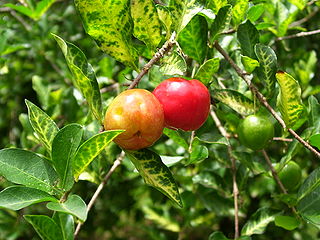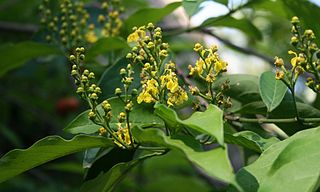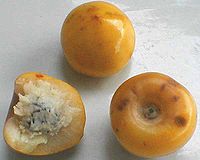
Abutilon is a large genus of flowering plants in the mallow family, Malvaceae. It is distributed throughout the tropics and subtropics of the Americas, Africa, Asia, and Australia. General common names include Indian mallow and velvetleaf; ornamental varieties may be known as room maple, parlor maple, or flowering maple. The genus name is an 18th-century Neo-Latin word that came from the Arabic ’abū-ṭīlūn, the name given by Avicenna to this or a similar genus.

Xylosma is a genus of flowering plants in the family Salicaceae. It contains around 100 species of evergreen shrubs and trees commonly known as brushhollies, xylosmas, or, more ambiguously, "logwoods". The generic name is derived from the Greek words ξύλον (xylon), meaning "wood, tree", and ὀσμή (osmé), meaning "smell", referring to the fragrant wood of some of the species. The Takhtajan system places it in the family Flacourtiaceae, which is considered defunct by the Angiosperm Phylogeny Group.

Psidium is a genus of trees and shrubs in the family Myrtaceae. It is native to warmer parts of the Western Hemisphere. Many of the species bear edible fruits, and for this reason several are cultivated commercially. The most popularly cultivated species is the common guava, Psidium guajava.

Paullinia is a genus of flowering shrubs, small trees and lianas in the soapberry family, Sapindaceae and typical of tribe Paullinieae. It is native to tropical South America, Central America and the Caribbean.

Plumeria, also known as frangipani, is a genus of flowering plants in the subfamily Rauvolfioideae, of the family Apocynaceae. Most species are deciduous shrubs or small trees. The species are native to the Neotropical realm, but are often grown as cosmopolitan ornamentals in tropical regions, especially in Hawaii, as well as hot desert climates in the Arabian Peninsula with proper irrigation.

The Sapotaceae are a family of flowering plants belonging to the order Ericales. The family includes about 800 species of evergreen trees and shrubs in around 65 genera. Their distribution is pantropical.

Byrsonima crassifolia is a species of flowering plant in the family Malpighiaceae, native to tropical America. Common names used in English include nance, maricao cimun, craboo, and golden spoon. In Jamaica it is called hogberry.

Malpighia is a genus of flowering plants in the nance family, Malpighiaceae. It contains 108 species of shrubs or small trees, all of which are native to the American tropics, ranging from Texas through Mexico, Central America, and the Caribbean to Venezuela, Colombia, and Ecuador. The generic name honours Marcello Malpighi, a 17th-century Italian physician and botanist. The species grow to 1–6 m (3.3–19.7 ft) tall, with a dense, often thorny crown. The leaves are evergreen, simple, 0.5–15 cm (0.20–5.91 in) long, with an entire or serrated margin. The flowers are solitary or in umbels of two to several together, each flower 1–2 cm (0.39–0.79 in) diameter, with five white, pink, red, or purple petals. The fruit is a red, orange, or purple drupe, containing two or three hard seeds. M. emarginata is cultivated for its sweet and juicy fruits, which are very rich in vitamin C.

Pisonia is a genus of flowering plants in the four o'clock flower family, Nyctaginaceae. It was named for Dutch physician and naturalist Willem Piso (1611–1678). Certain species in this genus are known as catchbirdtrees, birdcatcher trees or birdlime trees because they catch birds. The sticky seeds are postulated to be an adaptation of some island species that ensures the dispersal of seeds between islands by attaching them to birds, and also allows the enriching of coralline sands. These island species include P. brunoniana of Australasia and Polynesia and P. umbellifera, which is widespread in the tropical Indo-Pacific region.

Bunchosia is a genus in the Malpighiaceae, a family of about 75 genera of flowering plants in the order Malpighiales. It contains roughly 75 species of trees and shrubs, which are native to dry woodlands, savannas, and wet forests. Their range extends from Mexico and the Caribbean to southeastern Brazil and adjacent Argentina. Bunchosia is one of three arborescent genera of Malpighiaceae with fleshy, bird-dispersed fruits.
Byrsonima horneana is a species of plant in the Malpighiaceae family. It is endemic to Puerto Rico.

Rondeletia is a genus of flowering plants in the family Rubiaceae. It is endemic to the Neotropics. There are around 160 species.
The APG III system of flowering plant classification is the third version of a modern, mostly molecular-based, system of plant taxonomy being developed by the Angiosperm Phylogeny Group (APG). Published in 2009, it was superseded in 2016 by a further revision, the APG IV system.

Byrsonima lucida is a species of plant in the Malpighiaceae family. It is endemic to islands in the Caribbean and to the U.S. state of Florida. It is a shrub or small tree, and produces pink flowers. Its natural habitat is hammocks in dry limestone rocklands, and in sandy pine-palm woods.

Tetrapterys is a genus of flowering plants in the family Malpighiaceae, native to Latin America and the Caribbean, from Mexico through to Argentina, but excluding Chile. Small trees, shrubs or vines, they are known to be toxic to livestock if consumed for long periods of time, and T. mucronata and T. styloptera have hallucinogenic effects in humans similar to ayahuasca.














